The route this week took us to some bona-fide tourist destinations, including the beautiful ruins of Vat Phou, a smaller cousin of Angkor Wat, and it’s village of Champasak. The kingdom of Champasak was independent until the French forced it to be part of Laos around 1945. The ruins of the unfinished new palace are visible along the road.
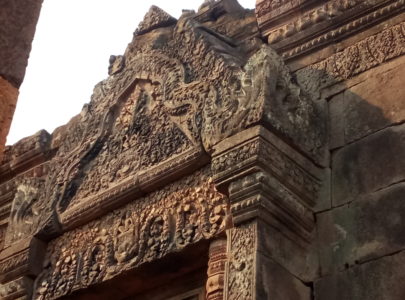 From there it was back across the Mekong via ferry and on to the 4000 Islands. Arriving at the next ferry crossing we found no ferries in service. Actually, the ferries are just motorized wooden long boats. People along the shore kept motioning further down the lane, and we were becoming increasingly confused. Finally we realized they were sending us to the new bridge several miles downstream. Well, we got in a few miles of great sandy single track along the riverside on the way. The only down side was that my pannier started rubbing with all the bouncing.
From there it was back across the Mekong via ferry and on to the 4000 Islands. Arriving at the next ferry crossing we found no ferries in service. Actually, the ferries are just motorized wooden long boats. People along the shore kept motioning further down the lane, and we were becoming increasingly confused. Finally we realized they were sending us to the new bridge several miles downstream. Well, we got in a few miles of great sandy single track along the riverside on the way. The only down side was that my pannier started rubbing with all the bouncing.
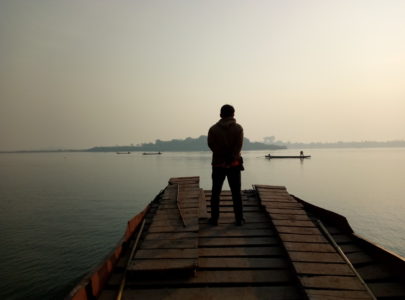 After a long, hot, sweaty day it’s great to find a guest house. We often are ready for bed not much past 8:00, and try for early mornings. Breakfast always seems to slow us down getting on the road, but this time it paid off and we met some other cyclists and made a good ferry connection to Don Det. From there it was an easy ride to Don Khone, the site of the waterfall that put the brakes on the French push up the river toward China in the 1870’s. The island still has two old steam locomotives and some re-purposed narrow gauge track.
After a long, hot, sweaty day it’s great to find a guest house. We often are ready for bed not much past 8:00, and try for early mornings. Breakfast always seems to slow us down getting on the road, but this time it paid off and we met some other cyclists and made a good ferry connection to Don Det. From there it was an easy ride to Don Khone, the site of the waterfall that put the brakes on the French push up the river toward China in the 1870’s. The island still has two old steam locomotives and some re-purposed narrow gauge track.
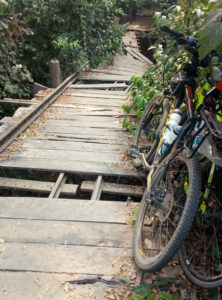 Limited accomodations put us into the guest house overflow tent but we met some interesting characters, a British filmaker and two families with young children taking extended vacations. A ferry ride back to the mainland then we rode on into Cambodia. Contrasts ensued. The area from the border to Stung Treng was markedly poorer and even more de-forested than Laos, though cashew plantations were going in. There was little traffic and the asphalt road surface was quickly reverting back into gravel. We saw few dwellings and none of the ubiquitous free-ranging cows and chickens in this area. This was Kampuchea in the 70’s. Around 4 million died under Pol Pot and the Khmer Rouge.
Limited accomodations put us into the guest house overflow tent but we met some interesting characters, a British filmaker and two families with young children taking extended vacations. A ferry ride back to the mainland then we rode on into Cambodia. Contrasts ensued. The area from the border to Stung Treng was markedly poorer and even more de-forested than Laos, though cashew plantations were going in. There was little traffic and the asphalt road surface was quickly reverting back into gravel. We saw few dwellings and none of the ubiquitous free-ranging cows and chickens in this area. This was Kampuchea in the 70’s. Around 4 million died under Pol Pot and the Khmer Rouge. 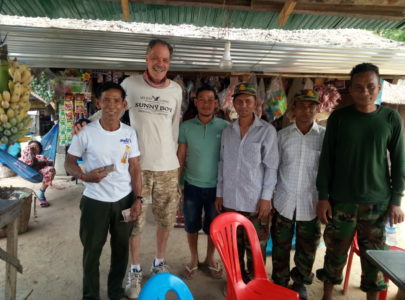 This region seems not to have caught up with the rest of Cambodia. We were glad to get to Stung Treng. It had also become even hotter, but the most amazing segment was yet to come. Our itinerary had our next night in Sambour, followed by a rest day of viewing endangered Irawaddy dolphins, doing our part for eco tourism. The route wasn’t entirely clear to me. Do we take the main road and backtrack up the shore? Do we take the meandering white line? We were tired of hot asphalt and I prefer gravel so we went for it. When maps.me wanted me to click on a disclaimer about the route once we got on it I should have known. Also the rock mining operation set up in the middle of the road some kms. down was a clue this road wasn’t used much. Then it got interesting and I wished I was on a mountain bike like Steve.
This region seems not to have caught up with the rest of Cambodia. We were glad to get to Stung Treng. It had also become even hotter, but the most amazing segment was yet to come. Our itinerary had our next night in Sambour, followed by a rest day of viewing endangered Irawaddy dolphins, doing our part for eco tourism. The route wasn’t entirely clear to me. Do we take the main road and backtrack up the shore? Do we take the meandering white line? We were tired of hot asphalt and I prefer gravel so we went for it. When maps.me wanted me to click on a disclaimer about the route once we got on it I should have known. Also the rock mining operation set up in the middle of the road some kms. down was a clue this road wasn’t used much. Then it got interesting and I wished I was on a mountain bike like Steve.
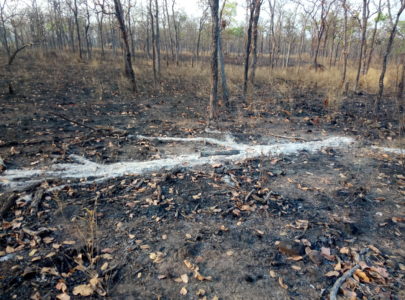 After another flat and miles of solitary desolation through de-forestation and burn-off, we arrived at a huge concrete plant (?!)where the “road” met the Mekong. There we started on a good looking gravel road only to find out a few mikes down it was the wrong one. Back to the factory and the dubious double track. At a very remote village along the river… the track disappeared. The blue GPS arrow on my map showed a road.
After another flat and miles of solitary desolation through de-forestation and burn-off, we arrived at a huge concrete plant (?!)where the “road” met the Mekong. There we started on a good looking gravel road only to find out a few mikes down it was the wrong one. Back to the factory and the dubious double track. At a very remote village along the river… the track disappeared. The blue GPS arrow on my map showed a road.
The villagers tried to send us in the right direction, but I think mostly they thought we didn’t know what we were doing. At this point I started wondering the same. Finally we found a trace of a cow path that seemed to align with the blue arrow. It was the “road.” It eventually, after many miles, took us to a hamlet at the rapids, where kids were hauling water up to use from the river below.
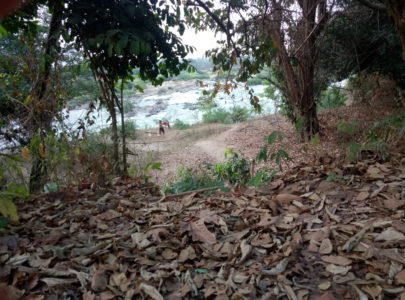 There was a road! The roadway waxed and waned between hamlets, but was visible and had periodic, passable plank bridges. At this point I knew we were going to be losing the sun, but at least we could follow the road with lights. Gradually the route became more populated, cows appeared with the biggest cow bells ever seen, and the first of the four weddings.
There was a road! The roadway waxed and waned between hamlets, but was visible and had periodic, passable plank bridges. At this point I knew we were going to be losing the sun, but at least we could follow the road with lights. Gradually the route became more populated, cows appeared with the biggest cow bells ever seen, and the first of the four weddings.
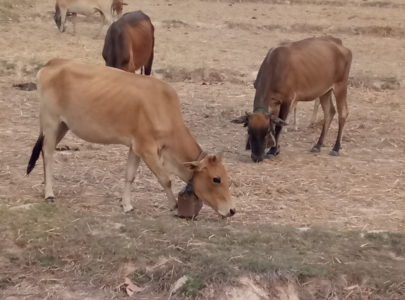 As in Laos, it’s wedding season, before the rains come, and they put on huge, multi-day extravaganzas. Some occupy the roadway, as the only flat space, to erect the tent and set up the tables. It’s the wedding industry gone amok. Most cannot afford such a display of bling and glitz. As we rode into Sambour, about an hour after nightfall, I saw searchlights in the sky and could already hear the over-amped sound system. As we rode into the biggest wedding party yet, a fellow approached us asking if we were looking for the guest house
As in Laos, it’s wedding season, before the rains come, and they put on huge, multi-day extravaganzas. Some occupy the roadway, as the only flat space, to erect the tent and set up the tables. It’s the wedding industry gone amok. Most cannot afford such a display of bling and glitz. As we rode into Sambour, about an hour after nightfall, I saw searchlights in the sky and could already hear the over-amped sound system. As we rode into the biggest wedding party yet, a fellow approached us asking if we were looking for the guest house
Why, yes! He was the owner, it was across the street, and there was one room left. The live band would shut down at 1:00.
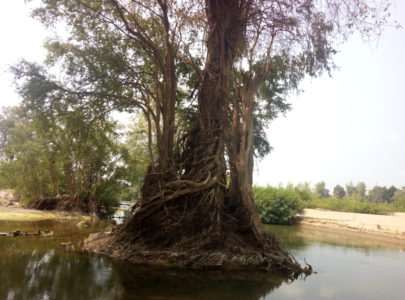 The only problem was that there was no longer dolphin viewing. The pod had died out. We got underway early the next morning to try our luck at Kampi, known for dolphin viewing, but they had no guest house. On to Kratie. Guest houses abounded, but no dolphins. Finally we took a kayaking tour back up river, dallied at the flooded forest, and got to see our dolphins at last, at Kampi.
The only problem was that there was no longer dolphin viewing. The pod had died out. We got underway early the next morning to try our luck at Kampi, known for dolphin viewing, but they had no guest house. On to Kratie. Guest houses abounded, but no dolphins. Finally we took a kayaking tour back up river, dallied at the flooded forest, and got to see our dolphins at last, at Kampi.

What an adventure. That broken bridge looks ominous.
You would know about broken bridges. We went back and around the other side of the island. This “bridge” used recycled narrow gauge track from the 1870’s or so as it’s support, but hasn’t been maintained lately.